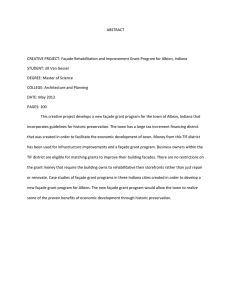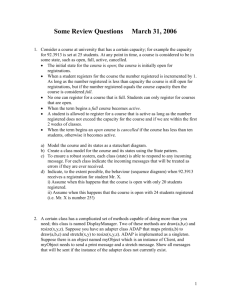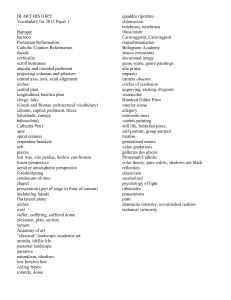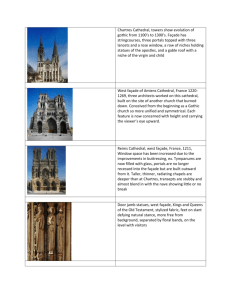SAINT ANTHONY'S CHAPEL FAÇADE PATHOLOGY DOCUMENTATION
advertisement
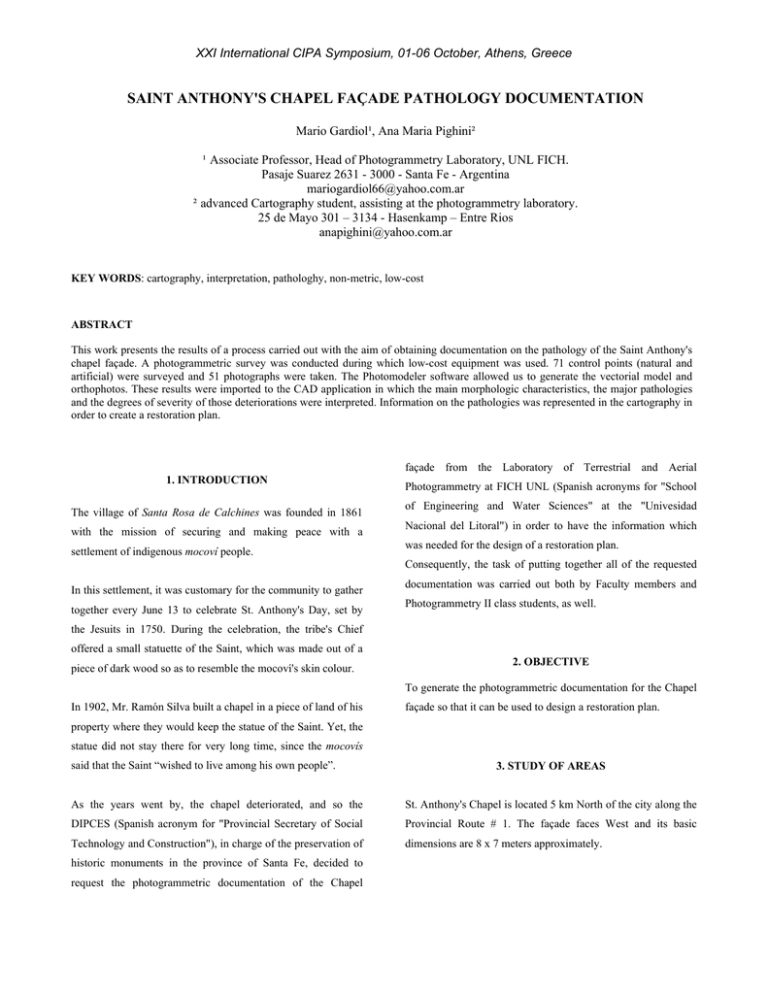
XXI International CIPA Symposium, 01-06 October, Athens, Greece SAINT ANTHONY'S CHAPEL FAÇADE PATHOLOGY DOCUMENTATION Mario Gardiol¹, Ana Maria Pighini² ¹ Associate Professor, Head of Photogrammetry Laboratory, UNL FICH. Pasaje Suarez 2631 - 3000 - Santa Fe - Argentina mariogardiol66@yahoo.com.ar ² advanced Cartography student, assisting at the photogrammetry laboratory. 25 de Mayo 301 – 3134 - Hasenkamp – Entre Rios anapighini@yahoo.com.ar KEY WORDS: cartography, interpretation, pathologhy, non-metric, low-cost ABSTRACT This work presents the results of a process carried out with the aim of obtaining documentation on the pathology of the Saint Anthony's chapel façade. A photogrammetric survey was conducted during which low-cost equipment was used. 71 control points (natural and artificial) were surveyed and 51 photographs were taken. The Photomodeler software allowed us to generate the vectorial model and orthophotos. These results were imported to the CAD application in which the main morphologic characteristics, the major pathologies and the degrees of severity of those deteriorations were interpreted. Information on the pathologies was represented in the cartography in order to create a restoration plan. façade from the Laboratory of Terrestrial and Aerial 1. INTRODUCTION The village of Santa Rosa de Calchines was founded in 1861 with the mission of securing and making peace with a settlement of indigenous mocoví people. Photogrammetry at FICH UNL (Spanish acronyms for "School of Engineering and Water Sciences" at the "Univesidad Nacional del Litoral") in order to have the information which was needed for the design of a restoration plan. Consequently, the task of putting together all of the requested In this settlement, it was customary for the community to gather together every June 13 to celebrate St. Anthony's Day, set by documentation was carried out both by Faculty members and Photogrammetry II class students, as well. the Jesuits in 1750. During the celebration, the tribe's Chief offered a small statuette of the Saint, which was made out of a piece of dark wood so as to resemble the mocoví's skin colour. 2. OBJECTIVE To generate the photogrammetric documentation for the Chapel In 1902, Mr. Ramón Silva built a chapel in a piece of land of his façade so that it can be used to design a restoration plan. property where they would keep the statue of the Saint. Yet, the statue did not stay there for very long time, since the mocovís said that the Saint “wished to live among his own people”. 3. STUDY OF AREAS As the years went by, the chapel deteriorated, and so the St. Anthony's Chapel is located 5 km North of the city along the DIPCES (Spanish acronym for "Provincial Secretary of Social Provincial Route # 1. The façade faces West and its basic Technology and Construction"), in charge of the preservation of dimensions are 8 x 7 meters approximately. historic monuments in the province of Santa Fe, decided to request the photogrammetric documentation of the Chapel XXI International CIPA Symposium, 01-06 October, Athens, Greece Figure 1. Saint Anthony´s chapel façade 4. METHOD AND EQUIPMENT The equipments and materials employed were as follows: - Pentax PCS-515 Total Station and accessories; - Level TOPCON AT-67 and accessories; - Topographic accessories; - Digital photographic camera FUJI Finepix A200 (1600 x Subsequently, a topographic base parallel of the façade and a 1200 pixels); local coordinate system was defined. The Total Station was set Software for managing and processing topographic and up on its vertices. Then, the control points angles were picture data; measured, and the X, Y and Z coordinates were calculated. - - Figure 2. Localization of artificial control points Photomodeler Pro 3.1. Coordinate control points were calculated using the software Initially, they visited the Chapel in order to collect general data, GEOD, developed by the Institut für Photogrammetrie und such as historical information, physical characteristics and Fernerkundung, of University of Karlsruhe (Germany). environment limits, basic dimensions and the extent of the pathologies affecting its façade, and also to undertake 4.2. Photographic survey photographic tests at different distances from the object. An FUJI Finepix A200 digital camera was employed for the 4.1. Topographic Surveying photographic survey. As it is not a metric camera, the Camera Calibrator 3.1 software was used so as to know its internal First, the photograph which more adequately registered the parameters. façade existing pathologies was selected out of the test images. Later, the distribution of the artificial control points was planned, taking into consideration the surface coverage of the chosen photography. The Photomodeler´s user manual recommend that a minimum of three images of the same control point be obtained. In this way, the geometric quality of a restored point increases, when the demarcation of it on other photographs also increases. Since we had not suitable equipment, we were not able to set up artificial control points on the upper section. However, 17 natural control points were identified. 33 horizontal photographs at a distance of 5 meters, and 18 slanted photos at 10 m, were taken as regular, convergent shots. XXI International CIPA Symposium, 01-06 October, Athens, Greece A ladder was used to take the pictures from the higher points. Moreover, detailed pictures were taken of the façade main ornaments. 4.4. Pathologic cartography After that, the vectorial file and orthophotos were imported to the CAD application. The orthophotos were scalated and 4.3. Restitution in Photomodeler spatially positioned. Besides, the orthophotos were processed through various embossing filters in order to emphasize the Firstly, project restitution for each area of study was created. pathologies. Objects and camera information was also incorporated. Secondly, control and auxiliary points were marked in one Then, the main morphologic features, the major pathologies and photograph and referencing other two photographs of the same the degrees of severity of those deteriorations were defined. sector. Then, restored points were processed and project quality These included the following: data were analyzed by the same software. Finally, three new - Main lines photographs were joined and the same steps were developed. - Secondary lines The same was done with all the photographs of the projects. - Capitals and column bases details - Blacksmith's works Project scaling was carried out using three points of the - Entrance gate topographic survey. A table with: id of point; X, Y and Z - Small cracks (up to 3 mm) coordinates; photos; tightness and angle was obtained. - Medium cracks (3 to 8 mm) - Major cracks (greater than 8 mm). - Deteriorated plaster - Fallen plaster - Replaced plaster - Deteriorated bricks - Invasive vegetation The pathologies were interpreted based on the orthophotos. In situations of indecision we had to have recourse to photographs of the details. Finally, a cartography of the façade was designed. 5. CONCLUSION After a first analisis, we are able to say that St. Anthony's Chapel façade presents a high percentage of deterioration. Figure 3. View of project restitution From the standpoint of morphology, the support base of the Finally, the vectorial file was exported in DXF format and then right columns is shorter than the support base of the left 18 orthophotos were generated: 10 of these focused on the depth columns. The main entrance door has missing portions and has of the façade's main wall, and the remaining 8 focused on other been poorly repaired. The capital of columns and the main architectural details found at different depths. details are well kept (Figure 4). XXI International CIPA Symposium, 01-06 October, Athens, Greece Dallas, R; 1992. A specification for the architectural With regards to pathologies, the major cracks are located mostly photogrametric survey of historic buildings and monuments. In: between the two main right-hand columns and in the upper CIPA INTERNACIONAL SYMPOSIUM, Vol XIII, 1990, triangle of the façade. Seemingly, the major crack, which is in Cracow. fact a fissure through the brick, is affecting the structure of wall, since the façade details are displaced vertically. (Figure 5). EOS SYSTEMS INC; 1997. Photomodeler Pro – user manual (v. 3.0). 11. ed. Canada. The fallen plaster, i.e. the exposed brick wall, is found chiefly in the lower section of the façade, and the most damaged areas are Waldhäusl, P. ; Peipe, J.; 1992. Control information in around its left side. These same sections are where deteriorated architectural photogrammetry. bricks show, and also where a few affected areas have been put SYMPOSIUM, Vol XIII, 1990, Cracow. In: CIPA INTERNACIONAL plaster on in recent years. Pais, F. Santito San Antonio, el santo de los mocovíes, Alma de Deteriorated plaster is seen almost in every area of the façade. Barrio. In URL: Nevertheless, when we look at the four main columns, it is http://www.santafeonline.com.ar/almadebarrio/index.cfm?notici noticeable that their right-hand sides are the ones which present a=424&s=noticiadetalle deteriorated plaster. This situation might be explained by the 12 February 2006. fact that the Southern wind is the prevailing wind in that region and, consequently, the column sides facing South are more severely affected than its other sides. (Figure 5). ACKNOWLEDGEMENTS Invasive vegetation, such as lichen and moss, grows around the We'd lilke to thank all members of Faculty and Photogrammetry Chapel and now is on the edges of the façade upper triangle, II class students who participated in this photogrammetric and a lower amount of it can be seen in the small triangle. Grass survey. and bracken has grown in the support base fissures. We also detected herbaceous plants on the roof, beside the cross. In conclusion, the photogrammetric documentation obtained by means of low-cost equipment presents enough information to establish the first stages of a restoration plan, chiefly by providing the ability to assess the sections of the façade which present higher degrees of deterioration as a result of the pathologies identified. REFERENCES Dallas, R.; 1996. Architectural and archaeological photogrammetry. In: Atkinson, K. Close range photogrammetry and machine vision. Scotland: Whittles Publishing,. XXI International CIPA Symposium, 01-06 October, Athens, Greece Figure 4. Morphologic features. Figure 5. Distribution of cracks and invasive vegetation Figure 6. State of plaster

